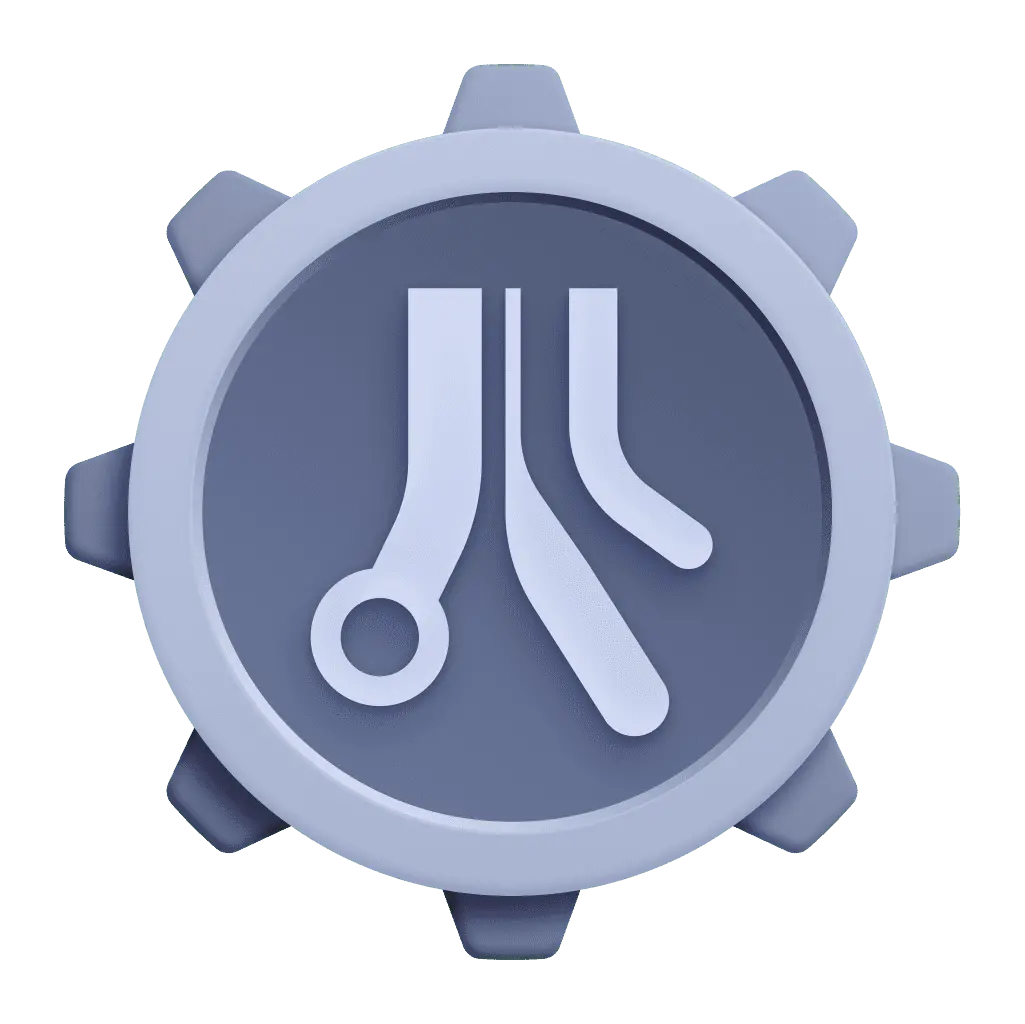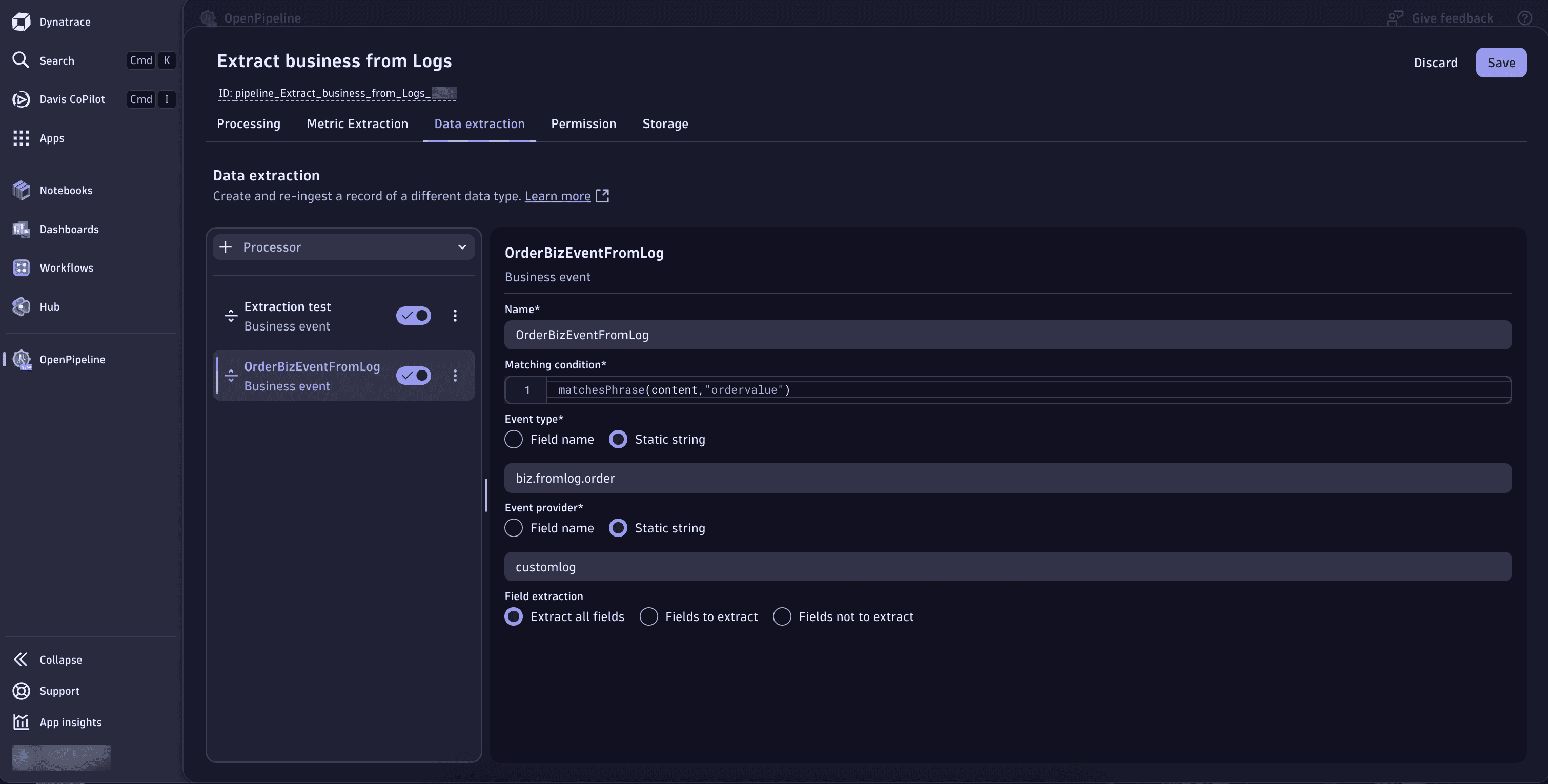Business event capture
To get started with business events, you first need to define the scope of the data you want to capture. The approach you use depends on the source of the business events.
There are four sources for business events.
-
Configure in Dynatrace to add capture rules, triggers, data fields, and more.
-
Obtain RUM business events by leveraging a dedicated method of the RUM JavaScript API, OneAgent for mobile, or OpenKit.
-
External sources
Configure external business or IT systems to send business events in JSON format to the business events API (REST endpoint).
-
Leverage logs as an additional source for business events using
 OpenPipeline.
OpenPipeline.
Get business events via OneAgent
OneAgent version 1.253+
To capture business events using OneAgent, you need to first enable the feature.
-
Go to Settings > Preferences > OneAgent features.
-
Enable the OneAgent business events feature for the technologies appropriate for your environment.
You need to restart the application process before you can capture business events from the process.
Configuration requires one or more capture rules that consist of triggers, mandatory data fields, and optional event data fields.
The table below contains examples of mandatory (event.type, event.provider) and optional (event.category) data fields.
event.categoryAvailabilityevent.typebuy-asset, sell-asset, loginevent.providerOneAgent, easyTrade.com, easyTravel.comSupported technologies
Supported technologies for data extraction from HTTP requests are listed in the tables below.
Data extraction from incoming HTTP requests
| Agent | OneAgent feature | Min. version | Technologies supported | Min. version | Compressed body | Full body | Min. version | Compressed body | Full body |
|---|---|---|---|---|---|---|---|---|---|
Enablement (event capture) | application/json (payload capture) | Header: XML (payload capture)1 | |||||||
Webserver | Webserver Business Events | 1.253 |
| 1.253 | 1.275 | ||||
.NET | .NET Business Events | 1.253 | 1.253 | 1.279 | |||||
Java | Java Business Events (incoming HTTP) | 1.253 | Servlet
| 1.253 | 1.275 | ||||
Node.js | Node.js Business Events | 1.259 | 1.259 | n/a | |||||
Golang | Go Business Events | 1.263 | 1.263 |
| n/a | ||||
Supported content types for XML capture on Java are application/xml.
Tomcat 10 support—OneAgent version 1.263+ and Java Servlet 5.0 Oneagent feature (in Settings > Preferences > OneAgent features) required
Data extraction from outgoing HTTP requests
| Agent | OneAgent feature | Min. version | Technologies supported | Min. version | Compressed body | Full body | Min. version | Compressed body | Full body |
|---|---|---|---|---|---|---|---|---|---|
Enablement (event capture) | application/json (payload capture) | Header: XML (payload capture)1 | |||||||
Webserver | n/a | n/a | n/a | n/a | n/a | n/a | n/a | n/a | n/a |
.NET | n/a | n/a | n/a | n/a | n/a | n/a | n/a | n/a | n/a |
Java | Java Business Events (outgoing HTTP) | 1.297+ | HTTP Clients
| 1.297+ | 1.297+ | ||||
Node.js | n/a | n/a | n/a | n/a | n/a | n/a | n/a | n/a | n/a |
Golang | n/a | n/a | n/a | n/a | n/a | n/a | n/a | n/a | n/a |
Capturing variants
This feature is available for OneAgent version 1.309+ on Webserver, .NET and Java. For all other technologies, apply the technology support table.
Define how incoming business events should be parsed based on their content-type.
To access the default configuration, Search for Capturing variants and select it.
Content-type
Parser
*/json
JSON
*/xml
XML
application/x-www-form-urlencoded
URL encoded
text/plain
Text
Those settings apply on the global level and are therefore used for all deployed agents on supported technologies.
Configure business event sources on OneAgent
OneAgent version 1.253+
To configure business event sources on OneAgent
-
Go to Settings > Business Analytics > OneAgent Business Event Sources.
-
Go to Incoming or Outgoing tab.
-
Select Add new capture rule and name your rule.
-
Select Add trigger to define a condition that will trigger a business event.
Determine the data source for your trigger, such as the request Body, Path, or HTTP Header. Then select an Operator and define a Value. This allows you to match content retrieved from the source to the value you define. When OneAgent matches the trigger, a business event is generated.
- The Summary displays the entire trigger rule (for example,
Request - Path starts with '/api/trade/BuyAssets). - By default, the Value is not case sensitive. Turn on Case sensitive if you want your trigger to consider the case of the source.
- Triggers are connected by
ANDlogic within a rule; if you set multiple triggers, all of them need to be fulfilled to capture a business event. - The first matching rule is executed per OneAgent per request.
- We recommend that you set specific triggers. If a trigger is too general and results in multiple identical rule matches, you will get multiple business events. For example, if you have a trigger condition
contains api, and the termapiis used in many of your applications, data can end up being captured from where it shouldn't be.
Do not create triggers where the value is simply
/; this can lead to overloading and shutting down your application environment. - The Summary displays the entire trigger rule (for example,
-
Select the Event provider source and value.
This describes the source of the event, such as
www.easytrade.com. The data source for this field can be a fixed value that you provide or it can be extracted from the event. -
Select the Event type source and value.
This describes the type of event sent by the event provider, such as
Asset purchase. -
optional Select Event category source and value to add helpful context to the event (for example, add a stock exchange name such as
NASDAQ).This step concludes the configuration of a business event that will be generated each time the trigger criteria are matched. This might be sufficient if all you need is to count the number of matching events (for example, to answer the question of how many asset purchases were made). In most cases, however, you will want to add event attributes for more granular insight (described in the step below). Attributes are data fields extracted from the event JSON or XML payload.
-
Select Add data field in Event data. Provide a field name, and then provide the data source and value from the JSON or XML payload. This describes the attribute-value pair that will be associated with the event, such as
accountId,amount,instrumentId, orprice. Adding such pairs can help you answer more complex questions such as how many accounts purchased a particular asset, which assets are purchased most often, or which accounts make the largest asset purchases.Example buy-asset request JSON file
{"accountId":6,"amount":10,"instrumentId":1,"price":157.025} -
Select Save changes.
-
Ensure that the rule is set to Enabled.
OneAgent capture rules can also be defined at the host or host-group level to limit the scope of capture.
Example of data extraction from JSON payloads
The following table shows additional examples of how to extract data from JSON payloads.
-
Request URL—
example.dynatrace.com/api?action=addItems -
Request headers
Accept—*/*Accept-Encoding—gzip, deflateAccept-Language—en-US,en;q=0.9Connection—keep-aliveContent-Length—64Content-Type—application/json
-
Request payload
{"time":"2022-03-12T12:16:36.5881611+00:00","transactionId":"1748-2b59-5c78-9c75-f500-274a-88f5-7965","user":{"user.id":"1684588","userName":"johndoe","name":"John","surname":"Doe","email":"me@johndoe.one"},"order":{"order.id":"58449798","retailer":{"id":"558","name":"HappyShop"},"amount":240.44,"currency":"usd","tags":["fancy","modern","classic","vintage"],"items":[{"itemId":"674","price":175.99,"productName":"Product A","productCategory":"Furniture","quantity":1},{"itemId":48,"price":12.89,"productName":"Product Z","productCategory":"Decoration","quantity":5}]}}
Examples of data extraction from XML payloads
The extraction of data from XML payloads works with the same syntax as for JSON.
Example 1: Extracting attributes and values from basic XML
<LogoutRequest id=”102030AF”><accountId>100</accountId></LogoutRequest>
Example 2: Extracting attributes and values from XML with namespaces
<?xml version="1.0" encoding="UTF-8"?><s:Envelope xmlns:s="http://schemas.xmlsoap.org/soap/envelope/"><s:Body><Tagh1 xmlns="http://tempuri.org/"><Tagh2 cusType="A" xmlns:a="http://schemas.datacontract.org/ex" xmlns:i="http://www.w3.org/2001/XMLSchema-instance"><a:Code i:nil="true" /><a:Name>MyCustomer1</a:Name><a:TotalValue>45</a:TotalValue></Tagh2></Tagh1></s:Body></s:Envelope>
Examples of data capture from requests and responses
Data capture from requests and responses is available for both JSON and XML.
The following table shows examples of how to extract data from requests and is based on the JSON payload example above.
- Field name—
RequestHeaders - Source—Request – HTTP header
- Path—
* - Description—Capture all header attributes
- Result—All header attributes as a string, separated by spaces
- Field name—
QueryParameters - Source—Request – Query string parameters
- Path—
* - Description—Capture all query string parameters
- Result—All query string parameters as a JSON-compatible string
Get business events from RUM
Business events are available for all Dynatrace RUM technologies (web RUM, mobile RUM, and OpenKit). RUM business events can be obtained by leveraging a dedicated method of the RUM JavaScript, OneAgent for mobile, or OpenKit.
Check the sections below for instructions on how to report business events for different platforms.
To report business events for the native part of Cordova applications, follow the instructions for Android or iOS. For the web part, use the RUM JavaScript.
let attributes = {"event.name": "Confirmed Booking","page": "booking-confirmation","product": "Danube Anna Hotel","amount": 358.35,"currency": "USD","reviewScore": 4.8,"arrivalDate": "2022-11-05","departureDate": "2022-11-15","journeyDuration": 10,"adultTravelers": 2,"childrenTravelers": 0};dynatrace.sendBizEvent('com.easytravel.funnel.booking-finished', attributes);
Business events are only captured for monitored sessions. When the RUM JavaScript is disabled either through a special method or due to cost and traffic control, business events are not reported for such sessions. Note that this behavior might be subject to change in the future, potentially allowing business events to be sent to Dynatrace regardless of session monitoring.
Log to Business events
Use  OpenPipeline to convert incoming logs to business events. This is useful if logs contain business-relevant information or no other ingest path for business events is available.
OpenPipeline to convert incoming logs to business events. This is useful if logs contain business-relevant information or no other ingest path for business events is available.
See the following log example to get started:
{"content": "{\"user\": \"009494\", \"ordervalue\": 1000}"}
- Launch
 OpenPipeline.
OpenPipeline. - Go to Logs and select the Pipelines tab.
- You can have multiple pipelines. Select the one that is used to take your loglines into processing.
- Go to the Data extraction tab.
- Open the Processor list on the left and select Business event to add a new Business Event processor.
- Fill out the fields with the following data:
- Name:
OrderBizEventFromLog - Matching condition:
matchesPhrase(content,"ordervalue") - Define Event type as Static string and enter:
biz.fromlog.order - Define Event provider as Static string and enter:
customlog - Set Field extraction to the fields that should be extracted:
Extract all fields
- Name:
- Select Save.

